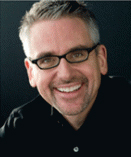The Deadly Sins of Public Speaking
An actor and public speaking expert shares a handful of the more common offenses

It wasn’t long after Rob Biesenbach (Col ’85) began acting about a decade ago that he saw the parallels between performance art and his day job in business communications.
“You learn to think about your audience, how to connect with and really move them,” Biesenbach says. “Business people can learn a lot from the world of performance. The ability to present your ideas in a compelling way is probably the most important skill you can have, even more so than writing.”
Biesenbach took the lessons he’s learned from acting—he’s appeared in a number of commercials for everything from Scottrade to OfficeMax since his first classes at Chicago’s famed Second City—and began carving out a new career as a public speaking expert. The work has led him to publish two books on the subject and to travel across the nation giving talks on what he says are the most common deadly sins of public speaking.
Below are a handful of some of the more common sins, as Biesenbach sees them:
Failure to Understand Your Audience
It’s not about you. It’s about them. Think about what your audience wants, and what you have in common with them.
Lack of Focus
If you try to say everything, you end up communicating nothing. Call the audience’s attention to a problem, quickly outline your recommended solution and get them intrigued enough to want to know or do more.
Poor Storytelling
Nothing beats a well-told story. Stories put a face on a problem, they humanize the storyteller and they connect us through universal values. What is a story? In its simplest form it tells of a character who pursues a goal in the face of an obstacle.
No Emotional Pull
Many speakers inundate us with facts and data without ever giving us a reason to care. Invest your ideas with passion and enthusiasm. Put your heart into it. This is not the time to be stoic. Don’t be afraid to let the cracks in your facade show.
Dull, Ugly Visuals
Like movies and TV, life is a visual medium. But amazingly, people often use their slides for scripts when images are demonstrably more effective in getting your point across. Start filling those PowerPoints with engaging images instead of endless bullet points.
Inadequate Rehearsal
If you’re not going to take this seriously, why should your audience? Too many people get the idea that they can just “wing it.” But the vast majority of us need to prepare. Otherwise we meander, get lost, fail to land messages just right and go over our allotted time.

Biesenbach’s Best
Rob Biesenbach (Col ’85) remembers two UVA professors who stood out as great public speakers when he was a student in the 1980s: economics professor Ken Elzinga and psychology professor Raymond Bice, who died in 2012.
“Both were experts in their subjects but they were able to capture these complex concepts in a way that was relatable to the audience,” says Biesenbach, who majored in English and American government. “They used creativity and storytelling to bring their lessons to life. I had a lot of other professors, but these two stick in my memory probably because they were such engaging speakers.”
Biesenbach, who grew up outside of Washington, D.C., says if you want to learn how to be a good public speaker, it doesn’t hurt to watch some great speeches. His favorites include Jesse Jackson’s address before the 1988 Democratic National Convention and Ronald Reagan’s speech after the Challenger disaster.
And then there is Ashton Kutcher’s speech at the Teen Choice Awards earlier this year.
“He surprised me,” Biesenbach says. “He spoke about some things you don’t typically associate with the world he’s from, like the importance of hard work and being smart. And he did it in a way that connected with an audience of screaming teens. That’s tough to do.”
Hear more speaking tips by Biesenbach in a recent webinar he presented or view a full archive of career webinars on alumni.virginia.edu.